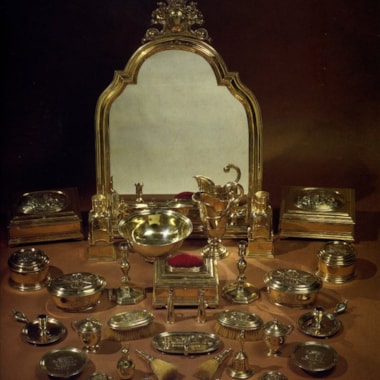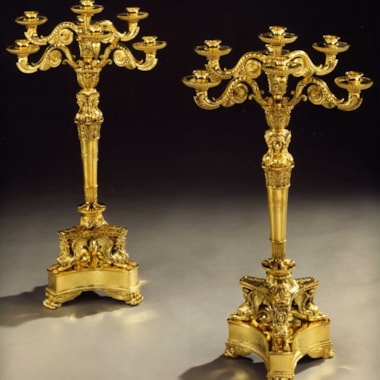The oval tureen has shaped bombé sides and rests on four ball and claw feet headed by lions’ masks, with a scroll and foliate loop handle at each end and a gadrooned rim; the sides are engraved with a coat of arms, motto, supporters and coronet. The loop handle of the conforming cover is set on a cartouche cast and chased with scrolling foliage, scalework, shells, eagles’ heads and lions’ masks. The cover is engraved with a crest.
The arms are those of Coventry probably for William, 5th Earl of Coventry (1678-1750) who married Elizabeth Allen, daughter of John Allen in 1719. He was M.P. for Bridport from 1708 to 1719 and succeeded to the title in 1719 following which he served as Lord-Lieutenant of Worcestershire until his death; he was also a Privy Councillor. He was a diligent custodian of the Coventry estates at Croome Court in Worcestershire; on becoming earl he ordered an inventory which detailed the repairs and maintenance that were required to the fabric of the house. Following his death his son, George William, 6th Earl of Coventry, spent a large proportion of his income on improving the house and park at Croome and he employed George Wickes and Samuel Netherton to refurbish his dinner service which included “new burnishing of terrines and covers”, “taking out and regraving of Arms” as well as putting new handles and feet on tureens.
The tureen is the same model as a pair of tureens of 1743 supplied to Sackville Tufton, 7th Earl of Thanet and now in the Cahn Collection (Ellenor Alcorn, Beyond the Maker’s Mark: Paul de Lamerie Silver in the Cahn Collection, 2006, p. 103, no. 38). A further tureen of 1751 engraved with the arms of Gorges, Lloyd and Sneyd belongs to Brasenose College, Oxford (Helen Clifford, Silver in London: The Parker and Wakelin Partnership 1760-1776, 2004, pp. 24-5, fig. 14).
The model dates from the middle of de Lamerie’s career. The earliest tureen bearing his mark is one of 1723, in the collection of the Duke of Bedford, which is circular and has a rim foot and formal Régence decoration (Michael Clayton, The Collector’s Dictionary of Silver and Gold of Great Britain and North Ameria, 1971, p. 365, pl. 62) which is clearly derived from French examples. By the late 1730s silversmiths had adopted the oval form resting on four mask or scroll feet, as in this example, which remained the basic form for tureens until the 1760s. Some examples, such as one supplied to George, 1st Baron Anson of 1750 (Susan Hare, Paul de Lamerie, The work of England’s Master Silversmith, 1990, p. 116, no. 73) have lively rococo ornament.
Tureens became fashionable in Britain during the 1720s and were used for the first course, and would have contained a variety of boiled meats, being already placed on the table when guests sat down to dine. They were removed for the second course of game, tarts and jellies (Ellenor Alcorn, op. cit., p. 104).
You May Also Like








































































